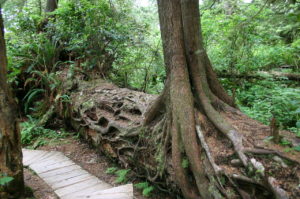
Jeremiah 33:14-16
Luke 21:25-36
Years ago, Kim and I visited the Muir Woods, north of San Francisco, to see the giant redwoods. They are truly magnificent trees, thick and tall, ancient and glorious as they soar up to the sky. They have existed on this earth for hundreds of thousands of years; each one can live to be hundreds of years old. They seem to live forever. But eventually they die, just like every living thing dies.
We saw some fallen redwoods in the forest, and that was the most interesting thing. Some of these long dead trunks had trees growing out of them, long straight new trunks reaching up to the sky. Even in death, these amazing trees gave birth to new life.
I learned later these are called nurse logs, or nursers. In the forest environment, these fallen trees are able to provide a suitable ecosystem for new seedlings to take root and grow. Consequently, when one tree dies, several can take its place. It doesn’t always happen, but it is beautiful when it does.
Just when it looks like death has the victory, life reasserts itself.
I look around at this time of the year at how everything seems to be dying, and I wonder if there ever was a time when people looked at the same signs and didn’t know if life would return to the land. Would the dry leaves that fall on the ground ever return to the trees, would the grass ever again grow, would the plants ever again bring forth food.
Would the warmth of the sun return. Would new life be born. I wonder if there was a time when people did not know that spring would come. I wonder what it would be like if you didn’t have that hope.
I lean on the poet T.S. Elliot, who said it better than I could:
What is the late November doing
with the disturbance of the spring
and creatures of the summer heat
and snowdrops writhing under feet
and hollyhocks that aim too high
red into grey and tumble down
late roses filled with early snow?
In the end of the life cycle is a beginning. Knowing this is to have hope. Because knowing, trusting, that the season of death and dormancy will pass, that beneath the surface new life is even now at work preparing for the spring, this is hope. And hope is where we begin on this first Sunday of Advent.
The season of Advent marks the beginning of the new year on the church calendar. We begin with preparing ourselves for the arrival of the Christ, newborn infant, new life, but also with the second arrival of the Christ, the idea that signifies the end of life as we know it. It is, indeed, a strange thing that we are beginning with both the beginning and the end of things.
We are beginning the Christian story with the end of the Christian story. During Advent, it is as if time collapses on itself: we look back, at the same time we look forward.
At the same time, we attempt to live in the present moment.
During this season of Advent, we will reflect on the practice of living in the present moment, something that is surprisingly hard to do. I can speak from personal experience when I say that the times when life hands you very stressful events, these are the times when we might find it nearly impossible to stay present in the here and now. We are hopelessly distracted. Our minds race between questioning what we should have done and wondering what might become, while trying to assert some control over things as they are now – things that seem well out of our control.
Despair overrides our efforts to be alert, be aware, be present.
It happens because we are afraid, afraid of all these things that are out of our control. Afraid of the worst possible things happening, afraid that we are already living in the worst possible thing. Sometimes we are so afraid that all we can see are the things we are afraid of.
And then we hear these words: “The days are surely coming, says the Lord, when I will fulfill the promise I made to the house of Israel and the house of Judah.”
A promise breaks through our fear! And, like so much of prophecy, we need to hear this as a promise that has been fulfilled already but also that we are still waiting for. It is something that has happened in the past but has not happened yet. And we are living in these strange between times, when we still see death all around us, but hold on to the promise that all life is being renewed.
In the hidden places all life is being renewed. In the end there is the beginning. And in the beginning is the end.
But these transitions can be terribly rough and jarring and unknown. This is clear as the scriptures speak of distress among nations, fear and foreboding of what is coming upon the world. We don’t glide through the transitions effortlessly, I am afraid.
Here again, Elliot has the words that I need:
In order to arrive at what you do not know
you must go by a way which is the way of ignorance.
In order to possess what you do not possess
you must go by the way of dispossession.
In order to arrive at what you are not
you must go through the way in which you are not.
We do not have a road map for this journey. So we listen to Jesus, we look to the fig tree. Jesus says to his disciples, “Look at the fig tree.”
The poor little fig tree is weighted down with so much baggage in the scriptures, more than it should have to bear. We should not confuse this parable of the fig tree with a different parable of the fig tree, in which the landowner threatens to cut down a three-year-old fig tree because it has not yet borne fruit. Nor should we confuse this parable with the stories in which Jesus curses a fig tree because it is not bearing fruit – although it is not the season for fruit.
In this parable the meaning is simpler, thankfully. Jesus reminds his disciples to watch the fig tree, and other trees. Notice when they sprout leaves. Because you know that when they sprout leaves summer is near. The leaves will be followed by fruit, the cycle of life will repeat itself.
Notice what he says here, because it’s important. Watch for the sprouting leaves. Jesus could have said to watch for when the leaves fall from the trees, because then you know winter is coming, and death. He does not say this – he says to look for the new life. Look at what is sprouting, look at what is about to be born.
These are the things we might fail to see – if we are not paying attention.
This is the way it is, when we are concerned with the past – regrets or wistfulness – and when we are concerned with the future – either what we are longing for or what we are dreading. When we are distracted by the past or the future, we neglect to be alert to what is happening right now.
But in this season of Advent, as we mark the beginning and the end, the new baby Jesus and the return of the Christ, let us look for signs of new life right in our midst.
There is no question that we see signs of change all around us. Our bodies change, very often in ways that do not please us. Our community changes, sometimes in ways that may worry us. The church changes in ways we don’t understand and we wonder what the future will bring. We don’t know what the future will bring.
But here is what we do know. We know that Jesus Christ is the alpha and omega, the beginning and the end. We know that life brings forth life and that in death there is the beginning of new life. We know that in our church and in our community, there are people who are caring for the sick, feeding the hungry, giving shelter to the homeless. We know there are people patiently teaching children the things they need to learn. We know there are people who are listening to others who need to be heard, lending a shoulder to those who need their strength. We know there are people who are intentionally spreading peace by small acts of kindness.
Look at the fig tree, see what it is doing. Look at the signs of life all around us, see where new things are sprouting. And remember that in each end is a new beginning. Look for the new beginnings, for there is our hope.
